Popular categories
Looking for a yarn?
The yarn cost is calculated from the pattern’s smallest size and the yarn’s cheapest product type. Looking for an even better price? You might find it on the DROPS Deals!
Winter Frill
Knitted sweater in DROPS Air. Piece is knitted top down with round yoke and flounce. Size: S - XXXL
DROPS design: Pattern ai-356
Yarn group C or A + A
----------------------------------------------------------
SIZE:
S - M - L - XL - XXL – XXXL
Finished measurements:
Chest measurements: 88-98-104-112-128-138 cm = 34⅝"-38½"-41"-44"-50⅜"-54¼"
Full length: 52-54-56-58-60-62 cm = 20½"-21¼"-22"-22¾"-23⅝"-24⅜"
All measurements in charts are in cm.
MATERIALS:
DROPS AIR from Garnstudio (belongs to yarn group C)
300-350-350-400-450-450 g color 02, wheat
NEEDLES:
DROPS CIRCULAR NEEDLE SIZE 5 MM = US 8 : Length 40 cm = 16" and 60-60-60-80-80-80 cm = 24"-24"-24"-32"-32"-32".
DROPS CIRCULAR NEEDLE SIZE 4 MM = US 6 : Length 40 and 60-60-60-80-80-80 cm = 24"-24"-24"-32"-32"-32"..
DROPS DOUBLE POINTED NEEDLES SIZE 5 MM = US 8
DROPS DOUBLE POINTED NEEDLES SIZE 4 MM = US 6
The technique MAGIC LOOP can be used – you then only need circular needle of 80 cm = 32" in each size.
KNITTING GAUGE:
17 stitches in width and 22 rows vertically in stockinette stitch = 10 x 10 cm = 4" x 4".
NOTE! Remember that needle size is only a suggestion. If you have too many stitches on 10 cm = 4" switch to larger needles. If you have too few stitches on 10 cm = 4" switch to smaller needles.
-------------------------------------------------------
Alternative Yarn – See how to change yarns here
Yarn Groups A to F – Use the same pattern and change the yarn here
Yarn usage using an alternative yarn – Use our yarn converter here
-------------------------------------------------------
The yarn cost is calculated from the pattern’s smallest size and the yarn’s cheapest product type. Looking for an even better price? You might find it on the DROPS Deals!
- English (US/in)
- Česky
- Dansk
- Deutsch
- Eesti keel
- English (UK/cm)
- Español
- Français
- Íslenska
- Italiano
- Magyar
- Nederlands
- Norsk
- Polski
- Português
- Suomi
- Svenska
- English (UK/cm), Bulgaria
- English (UK/cm), Croatia
- English (UK/cm), Greece
- English (UK/cm), Latvia
- English (UK/cm), Lithuania
- English (UK/cm), Romania
- English (UK/cm), Slovenia
- Česky, Slovakia
Pattern instructions
EXPLANATION FOR THE PATTERN:
----------------------------------------------------------
GARTER STITCH (back and forth):
Knit all rows.
1 ridge vertically = knit 2 rows.
INCREASE TIP (evenly):
To calculate how to increase evenly, use the total number of stitches on row (e.g. 92 stitches) and divide stitches by number of increases to be done (e.g. 13) = 7.1.
In this example increase by making 1 yarn over after approx. every 7th stitch. On next round work yarn overs twisted to avoid holes.
PATTERN:
See diagram A.1.
DECREASE TIP (applies to sleeves):
Decrease 1 stitch on each side of marker thread as follows: Work until 3 stitches remain before marker thread and knit 2 together, knit 2 (marker thread is between these stitches), slip 1 stitch knitwise, knit 1, pass slipped stitch over stitch worked.
BIND-OFF TIP:
To avoid a tight bind-off edge when binding off, you may use a larger needle. If this still is too tight make 1 yarn over after approx. every 4th stitch while binding off (bind off yarn overs as stitches).
----------------------------------------------------------
START THE PIECE HERE:
----------------------------------------------------------
SWEATER - SHORT OVERVIEW OF THE PIECE:
Worked in the round on circular needle, top down. Work double neck edge and yoke in the round on circular needle from mid back, top down. Increase stitches on yoke. Now divide yoke for body and sleeves. Work the body in the round on circular needle, work sleeves in the round on a double pointed needles / short circular needle. Work a flounce that are sewn to the yoke at the end.
NECK EDGE:
Cast on 72-84-88-92-96-100 stitches on short circular needle size 5 MM = US 8 with DROPS Air. Knit 1 round. Switch to a short circular needle size 4 MM = US 6. Work rib (= knit 2 twisted/purl 2). Work until rib measures 9 cm = 3½". The neck edge is later folded double and assembled so that the neck edge is approx. 4 cm = 1½".
YOKE:
Switch to circular needle size 5 MM = US 8. Insert 1 marker at beginning of round (= mid back), measure yoke from this marker! Knit 1 row from right side while increasing 3-1-2-13-14-15 stitches evenly - read INCREASE TIP = 75-85-90-105-110-115 stitches.
Work in stockinette stitch until piece measures 3 cm = 1⅛". REMEMBER THE KNITTING GAUGE!
On next round work A.1 over all stitches (= 15-17-18-21-22-23 repetitions of 5 stitches). When A.1 has been worked, there are 30-34-36-42-44-46 stitches= 105-119-126-147-154-161 stitches. Continue then in stockinette stitch until piece measures 9-9-10-10-11-11 cm = 3½"-3½"-4"-4"-4⅜"-4⅜" from marker.
Work next round as follows: Knit 0-2-1-1-2-1, A.1 over the next 105-115-125-145-150-160 stitches (= 21-23-25-29-30-32 repetitions of 5 stitches), knit 0-2-0-1-2-0. When A.1 has been worked, there are 42-46-50-58-60-64 stitches= 147-165-176-205-214-225 stitches. When piece measures 10-10-11-11-12-12 cm = 4"-4"-4⅜"-4⅜"-4¾"-4¾", pull 1 marker thread through all stitches on needle. This is used later when sewing flounce on to sweater Then continue in stockinette stitch until piece measures 15-16-17-18-19-20 cm = 6"-6¼"-6¾"-7"-7½"-8" from marker.
Work next round as follows: Knit 1-0-1-0-2-0, A.1 over the next 145-165-175-205-210-225 stitches (= 29-33-35-41-42-45 repetitions of 5 stitches), knit 1-0-0-0-2-0. When A.1 has been worked, there are 58-66-70-82-84-90 stitches= 205-231-246-287-298-315 stitches. Continue with stockinette stitch until piece measures 20-22-23-25-27-29 cm = 8"-8¾"-9"-9¾"-10⅝"-11⅜", now increase 27-29-26-17-26-29 stitches evenly = 232-260-272-304-324-344 stitches.
Now divide yoke for body and sleeves as follows:
Knit 34-39-40-44-49-53 (= half back piece), slip the next 48-52-56-64-64-66 stitches on 1 stitch holder for sleeve, cast on 6-6-8-8-10-12 new stitches on row (= in the side under sleeve), knit 68-78-80-88-98-106 (= front piece), slip the next 48-52-56-64-64-66 stitches on 1 stitch holder for sleeve, cast on 6-6-8-8-10-12 new stitches on row (= in the side under sleeve) and knit the remaining 34-39-40-44-49-53 stitches as before (= half back piece). Finish body and sleeves separately. NOW MEASURE THE PIECE FROM HERE!
BODY:
There are now 148-168-176-192-216-236 stitches on round. Continue in stockinette stitch. Work until piece measures 18-18-19-19-19-19 cm = 7"-7"-7½"-7½"-7½"-7½" from division. 10 cm = 4" remain until finished measurements. Try the sweater and work to desired length. Now increase stitches to avoid the rib from contracting. Knit 1 round while increasing 32-32-36-40-44-48 stitches evenly = 180-200-212-232-260-284 stitches. Switch to circular needle size 4 MM = US 6 and work rib = knit 2 twisted /purl 2 in the round. Work rib for 10 cm = 4". Bind off loosely with knit over knit and purl over purl - read BIND-OFF TIP. Sweater measures approx. 52-54-56-58-60-62 cm = 20½"-21¼"-22"-22¾"-23⅝"-24⅜" from shoulder and down.
SLEEVE:
Slip the 48-52-56-64-64-66 stitches from stitch holder in one side of piece on a short circular needle / double pointed needles size 5 MM = US 8 and pick up 1 stitch in each of the 6-6-8-8-10-12 new stitches cast on under sleeve = 54-58-64-72-74-78 stitches. Insert 1 marker thread mid under sleeve, i.e. in the middle of the 6-6-8-8-10-12 stitches that were cast on under sleeves. Move the marker thread upwards when working; it should be used for decrease mid under sleeve. Begin round at the marker thread and work stockinette stitch in the round.
When sleeve measures 3 cm = 1⅛" from division, decrease 2 stitches mid under sleeve - read DECREASE TIP. Decrease like this every 8-5-3-2½-2-2 cm = 3⅛"-2"-1⅛"-1"-¾"-¾" 4-5-7-10-10-11 times in total = 46-48-50-52-54-56 stitches. Continue without decreases until sleeve measures 32-30-30-29-28-26 cm = 12½"-11¾"-11¾"-11⅜"-11"-10¼" from division (shorter measurements in the larger sizes because of wider neck and longer yoke). 10 cm = 4" remain until finished measurements. Try the sweater and work to desired length. Knit 1 round while increasing 6-4-6-4-6-4 stitches evenly = 52-52-56-56-60-60 stitches. Switch to double pointed needles size 4 MM = US 6. Work rib in the round (= knit 2 twisted/purl 2) for 10 cm = 4". Bind off with knit over knit and purl over purl - remember BIND-OFF TIP.
Sleeve measures approx. 42-40-40-39-38-36 cm = 16½"-15¾"-15¾"-15¼"-15"-14¼" from division. Work the other sleeve the same way.
FLOUNCE:
Work flounce back and forth on circular needle, and fasten to front side of sweater, from one shoulder to the other. If you want flounce around the entire sweater, double the number of stitches. Cast on 74-82-86-102-106-114 stitches on circular needle size 4 MM = US 6 with DROPS Air. Work 2 ridges in GARTER STITCH - read explanation above. Switch to circular needle size 5 MM = US 8. Now in stockinette stitch, and increase stitches as follows:
ROW 1 (= right side): * Knit 2, make 1 yarn over *, work from *-* until 2 stitches remain on row, and finish with knit 2. 36-40-42-50-52-56 stitches have been increased and there are 110-122-128-152-158-170 stitches on needle.
ROW 2 (= wrong side): Purl all stitches, purl yarn overs (to make holes).
ROW 3 (= right side): * Knit 3, make 1 yarn over *, work from *-* until 2 stitches remain on row, and finish with knit 2. 36-40-42-50-52-56 stitches have been increased and there are 146-162-170-202-208-226 stitches on needle.
ROW 4 (= wrong side): Purl all stitches, purl yarn overs (to make holes).
Work in stockinette stitch until piece measures approx. 8-9-9-9-10-10 cm = 3⅛"-3½"-3½"-3½"-4"-4", and adjust so that next row is worked from wrong side. * Purl 2, knit 2 *, repeat *-* the entire row. Loosely bind off on next row, bind off with knit over knit and purl over purl.
ASSEMBLY:
Fasten flounce to front side of sweater, from shoulder to shoulder. Fasten flounce along marker thread inserted into yoke, with small stitches. Pull out the marker thread. Fold rib at the top of neck down on inside of garment. Fasten rib to get a double neck edge. To avoid a tight neck edge that sticks out it is important to keep the seam elastic.
Diagram
All measurements in charts are in cm.

|
= knit |

|
= knit 1 without dropping stitch off the needle, 1 yarn over, knit 1 in same stitch but in back loop. On next round knit yarn overs twisted to avoid holes (= 2 stitches increased) |

What can you do with our patterns? You can share DROPS patterns online, using the pattern original picture, materials, name and number. But you are NOT ALLOWED to reproduce the complete pattern digitally in any way. Yarn stores are welcome to use the DROPS pattern database to promote the sale of our assortment. You can print out our patterns, make as many copies as you’d like. The only thing we ask is that you don't make any changes / additions to the original printed document. And that the patterns according to the DROPS philosophy are given out to the consumers for free. Editorials that wish to publish our patterns in printed books or magazines can contact us for more information. The sale of garments based on DROPS patterns is permitted as long as they are sold as single items or per order. Further commercial use of the patterns is not permitted. It has to be clearly stated that the garment is made based on a design from DROPS DESIGN. The use of clothing labels of which DROPS DESIGN forms part is conditioned by the inclusion of the following text: “A DROPS DESIGN made by …..”. The use of DROPS photos for marketing purposes/sales is only permitted in connection with the use/sale of DROPS products. The photos may not be cut or edited and the logo should be clearly visible.
We reserve the right to withdraw the permission for use of our patterns at any time, notwithstanding the reason.
Each of our patterns has specific tutorial videos to help you.
These step-by-step tutorials might also help you:
Why is the knitting/crochet tension so important?
Knitting tension is what determines the final measurements of your work, and is usually measured per 10 x 10 cm. It is provided like so: number of stitches in width x number of rows in height - eg: 19 stitches x 26 rows = 10 x 10 cm.
The knitting tension is very individual; some people knit/crochet loosely while others work tightly. You adjust the knitting tension with the needle size, which is why the suggested needle size only serve as a guide! You need to adjust this (up or down) to ensure that YOUR knitting tension matches the knitting tension provided in the pattern. If you work with a different knitting tension than provided you will have a different yarn consumption, and your work will have different measurements than what the pattern suggests.
The knitting tension also determines which yarns can replace each other. As long as you achieve the same knitting tension you can replace one yarn with another.
See DROPS lesson: How to measure your tension/gauge
See DROPS video: How to make a gauge tension swatch
How do I know how many balls of yarn I need?
The required amount of yarn is provided in grams, eg: 450 g. To calculate how many balls you’ll need you first need to know how many grams are in 1 ball (25g, 50g or 100g). This information is available if you click on the individual yarn quality on our pages. Divide the amount required with the amount of each ball. For example, if each ball is 50g (the most common amount), the calculation will be as follows: 450 / 50 = 9 balls.
Can I use a different yarn than what the pattern suggests?
The important thing when changing from one yarn to another is that the knitting/crochet tension remains the same. This is so that the measurements of the finished piece will be the same as on the sketch provided. It is easier to achieve the same knitting tension using yarns from the same yarn group. It is also possible to work with multiple strands of a thinner yarn to achieve the knitting tension of a thicker one. Please try our yarn converter. We recommend you to always work a test swatch.
Please NOTE: when changing yarn the garment might have a different look and feel to the garment in the photo, due to individual properties and qualities of each yarn.
See DROPS lesson: Can I use a different yarn than the one mentioned in the pattern?
What are the yarn groups?
All our yarns are categorised into yarn groups (from A to F) according to thickness and knitting tension – group A contains the thinnest yarns and group F the thickest. This makes it easier for you to find alternative yarns to our patterns, should you wish to switch yarn. All yarns within the same group have a similar knitting tension and can easily replace each other. However, different yarn qualities have different structures and properties which will give the finished work a unique look and feel.
How do I use the yarn converter?
At the top of all our patterns you’ll find a link to our yarn converter, which is a helpful tool should you wish to use a different yarn than suggested. By filling in the yarn quality you wish to replace, the amount (in your size) and number of strands, the converter will present good alternative yarns with the same knitting tension. Additionally it will tell you how much you’ll require in the new qualities and whether you’ll need to work with multiple strands. Most skeins are 50g (some are 25g or 100g).
If the pattern is worked with multiple colours, every colour will have to be converted separately. Similarly, if the pattern is worked with several strands of different yarns (for example 1 strand Alpaca and 1 strand Kid-Silk) you will have to find alternatives for each, individually.
Why do you show discontinued yarns in the patterns?
Since different yarns have different qualities and textures we have chosen to keep the original yarn in our patterns. However, you can easily find options among our available qualities by using our yarn converter, or simply pick a yarn from the same yarn group.
It is possible that some retailers still have discontinued yarns in stock, or that someone has a few skeins at home that they would like to find patterns for.
The yarn converter will provide both alternative yarn as well as required amount in the new quality.
What size should I knit?
If you think it's hard to decide what size to make, it can be a good idea to measure a garment you own already and like the size of. Then you can pick the size by comparing those measures with the ones available in the pattern's size chart.
You'll find the size chart at the bottom of the pattern.
See DROPS lesson: How to read size chart
Why do I get the wrong knitting tension with the suggested needle size?
The needle size provided in the pattern serves only as a guide, the important thing is to follow the knitting tension. And since knitting tension is very individual, you will have to adjust the needle size to ensure that YOUR tension is the same as in the pattern – maybe you’ll have to adjust 1, or even 2 needle sizes, up or down to achieve the correct tension. For this, we recommend that you work test swatches.
Should you work with a different knitting tension than the one provided, the measurements of the finished garment might deviate from the measurement sketch.
See DROPS lesson: How to measure your tension/gauge
See DROPS video: How to make a gauge tension swatch
Why is the pattern worked top-down?
Working a garment top-down provides more flexibility and room for personal adjustment. For example it is easier to try the garment on while working, as well as making adjustments to length of yoke and shoulder caps.
The instructions are carefully explaining every step, in the correct order. Diagrams are adjusted to the knitting direction and are worked as usual.
How do I work according to a knitting diagram?
The diagram depicts all rows/rounds, and every stitch seen from the right side. It is read from bottom to top, from right to left. 1 square = 1 stitch.
When working back and forth, every other row is worked from the right side and every other row is worked from the wrong side. When working from the wrong side, the diagram will have to be worked reversed: from left to right, knit stitches are purled, purl stitches are knit etc.
When working in the round every round is worked from the right side and the diagram are worked from right to left on all rounds.
See DROPS lesson: How to read knitting diagrams
How do I work according to a crochet diagram?
The diagram depicts all rows/rounds, and every stitch seen from the right side. It is worked from bottom to top, from right to left.
When working back and forth every other row is worked from the right side: from right to left and every other row is worked from the wrong side: from left to right.
When working in the round, every row in the diagram are worked from the right side, from right to left.
When working a circular diagram you start in the middle and work your way outwards, counter clockwise, row by row.
The rows usually start with a given number of chain stitches (equivalent to the height of the following stitch), this will either be depicted in the diagram or explained in the pattern.
See DROPS lesson: How to read crochet diagrams
How do I work several diagrams simultaneously on the same row/round?
Instructions for working several diagrams after each other on the same row/round, will often be written like so: “work A.1, A.2, A.3 a total of 0-0-2-3-4 times". This means you work A.1 once, then A.2 is worked once, and A.3 is repeated (in width) the number of times provided for your size – in this case like so: S = 0 times, M = 0 times, L=2 times, XL= 3 times and XXL = 4 times.
The diagrams are worked as usual: begin with the first row in A.1, then work the first row in A.2 etc.
See DROPS lesson: How to read knitting diagrams
See DROPS lesson: How to read crochet diagrams
Why are the sleeves shorter in larger sizes?
The total width of the garment (from wrist-to-wrist) will be larger in the larger sizes, despite the actual sleeves being shorter. The larger sizes have longer sleeve caps and wider shoulders, so there will be a good fit in all sizes.
Where on the garment is the length measured?
The measurement sketch/schematic drawing provides information regarding the full length of the garment. If it’s a jumper or a jacket the length is measured from the highest point on the shoulder (usually closest to the neckline), and straight down to the bottom of the garment. It is NOT measured from the tip of shoulder. Similarly, the length of yoke is measured from the highest point on the shoulder and down to where yoke is split into body and sleeves.
See DROPS lesson: How to read a schematic drawing
What is a repeat?
Diagrams are often repeated on the round or in height. 1 repeat is the diagram the way it appears in the pattern. If it says to work 5 repeats of A.1 in the round, then you work A.1 a total of 5 times after/next to each other in the round. If it says to work 2 repeats of A.1 vertically/in height you work the entire diagram once, then begin again at the start and work the entire diagram one more time.
Why does the piece start with more chain stitches than it’s worked with?
Chain stitches are slightly narrower than other stitches and to avoid working the cast-on edge too tight, we simply chain more stitches to begin with. The stitch count will be adjusted on the following row to fit the pattern and measurement sketch.
Why increase before the rib edge when the piece is worked top-down?
The rib edge is more elastic and will contract slightly compared to, for example, stocking stitch. By increasing before the rib edge, you avoid a visible difference in width between the rib edge and the rest of the body.
Why increase in the cast-off edge?
It’s very easy to cast off too tightly, and by making yarn overs while casting off (and simultaneously casting these off) you avoid a too tight cast off edge.
See DROPS video: How to bind off with yarn overs (yo)
How do I increase/decrease on every 3rd and 4th row/round alternately?
To achieve an even increase (or decrease) you can increase on, for example: every 3rd and 4th row alternately, like so: work 2 rows and increase on the 3rd row, work 3 rows and increase on the 4th. Repeat this until the increase is complete.
See DROPS lesson: Increase or decrease 1 st on every 3rd and 4th row alternately
How can I work a jacket in the round instead of back and forth?
Should you prefer to work in the round instead of back and forth, you may of course adjust the pattern. You’ll need to add steeks mid-front (usually 5 stitches), and follow the instructions. When you would normally turn and work from the wrong side, simply work across the steek and continue in the round. At the end you’ll cut the piece open, pick up stitches to work bands, and cover the cut edges.
See DROPS video: How to knit steeks and cut open
Can I work a jumper back and forth instead of in the round?
Should you prefer to work back and forth instead of in the round, you may of course adjust the pattern so you work the pieces separately and then assemble them at the end. Divide the stitches for the body in 2, add 1 edge stitch in each side (for sewing) and work the front and back pieces separately.
See DROPS lesson: Can I adapt a pattern for circular needles into straight needles?
Why is the pattern slightly different than what I see in the photo?
Pattern repeats can vary slightly in the different sizes, in order to get the correct proportions. If you’re not working the exact same size as the garment in the photo, yours might deviate slightly. This has been carefully developed and adjusted so that the complete impression of the garment is the same in all sizes.
Make sure to follow instructions and diagrams for your size!
How do I make a women’s size garment into a men’s size one?
If you have found a pattern you like which is available in women’s size it’s not very difficult to convert it to men’s size. The biggest difference will be the length of sleeves and body. Start working on the women size that you think would fit across the chest. The additional length will be worked right before you cast off for the armhole/sleeve cap. If the pattern is worked top-down you can add the length right after the armhole or before the first decrease on sleeve.
Regarding additional yarn amount, this will depend on how much length you add, but it is better with a skein too many than too few.
How do I prevent a hairy garment from shedding?
All yarns will have excess fibres (from production) that might come off as lint or shedding. Brushed yarns (ie hairier yarns) have more of these loose, excess fibres, causing more shedding.
Shedding also depends on what is worn under or over the garment, and whether this pulls at the yarn fibres. It’s therefore not possible to guarantee that there will be no shedding
Below are some tips on how to get the best result when working with hairier yarns:
1. When the garment is finished (before you wash it) shake it vigorously so the looser hairs come off. NOTE: do NOT use a lint roller, brush or any method that pulls at the yarn.
2. Place the garment in a plastic bag and put it in your freezer - the temperature will cause the fibres to become less attached to each other, and excess fibres will come off easier.
3. Leave in the freezer for a few hours before taking it out and shaking it again.
4. Wash the garment according to the instructions on the yarn label.
Why does my garment pill?
Pilling is a natural process that happens to even the most exclusive of fibers. It's a natural sign of wear and tear that is hard to avoid, and that is most visible in high friction areas of your garment like a sweater's arms and cuffs.
You can make your garment look as new by removing the pilling, using a fabric comb or a pill/lint remover.
In the meantime, you can read the questions and answers that others have left to this pattern or join the DROPS Workshop on Facebook to get help from fellow knitters/crocheters!
You might also like...
Winter Frill
Winter Frill
Winter Frill |
|||||||
 |
 |
||||||
Knitted sweater in DROPS Air. Piece is knitted top down with round yoke and flounce. Size: S - XXXL
DROPS 227-12 |
|||||||
|
---------------------------------------------------------- EXPLANATION FOR THE PATTERN: ---------------------------------------------------------- GARTER STITCH (back and forth): Knit all rows. 1 ridge vertically = knit 2 rows. INCREASE TIP (evenly): To calculate how to increase evenly, use the total number of stitches on row (e.g. 92 stitches) and divide stitches by number of increases to be done (e.g. 13) = 7.1. In this example increase by making 1 yarn over after approx. every 7th stitch. On next round work yarn overs twisted to avoid holes. PATTERN: See diagram A.1. DECREASE TIP (applies to sleeves): Decrease 1 stitch on each side of marker thread as follows: Work until 3 stitches remain before marker thread and knit 2 together, knit 2 (marker thread is between these stitches), slip 1 stitch knitwise, knit 1, pass slipped stitch over stitch worked. BIND-OFF TIP: To avoid a tight bind-off edge when binding off, you may use a larger needle. If this still is too tight make 1 yarn over after approx. every 4th stitch while binding off (bind off yarn overs as stitches). ---------------------------------------------------------- START THE PIECE HERE: ---------------------------------------------------------- SWEATER - SHORT OVERVIEW OF THE PIECE: Worked in the round on circular needle, top down. Work double neck edge and yoke in the round on circular needle from mid back, top down. Increase stitches on yoke. Now divide yoke for body and sleeves. Work the body in the round on circular needle, work sleeves in the round on a double pointed needles / short circular needle. Work a flounce that are sewn to the yoke at the end. NECK EDGE: Cast on 72-84-88-92-96-100 stitches on short circular needle size 5 MM = US 8 with DROPS Air. Knit 1 round. Switch to a short circular needle size 4 MM = US 6. Work rib (= knit 2 twisted/purl 2). Work until rib measures 9 cm = 3½". The neck edge is later folded double and assembled so that the neck edge is approx. 4 cm = 1½". YOKE: Switch to circular needle size 5 MM = US 8. Insert 1 marker at beginning of round (= mid back), measure yoke from this marker! Knit 1 row from right side while increasing 3-1-2-13-14-15 stitches evenly - read INCREASE TIP = 75-85-90-105-110-115 stitches. Work in stockinette stitch until piece measures 3 cm = 1⅛". REMEMBER THE KNITTING GAUGE! On next round work A.1 over all stitches (= 15-17-18-21-22-23 repetitions of 5 stitches). When A.1 has been worked, there are 30-34-36-42-44-46 stitches= 105-119-126-147-154-161 stitches. Continue then in stockinette stitch until piece measures 9-9-10-10-11-11 cm = 3½"-3½"-4"-4"-4⅜"-4⅜" from marker. Work next round as follows: Knit 0-2-1-1-2-1, A.1 over the next 105-115-125-145-150-160 stitches (= 21-23-25-29-30-32 repetitions of 5 stitches), knit 0-2-0-1-2-0. When A.1 has been worked, there are 42-46-50-58-60-64 stitches= 147-165-176-205-214-225 stitches. When piece measures 10-10-11-11-12-12 cm = 4"-4"-4⅜"-4⅜"-4¾"-4¾", pull 1 marker thread through all stitches on needle. This is used later when sewing flounce on to sweater Then continue in stockinette stitch until piece measures 15-16-17-18-19-20 cm = 6"-6¼"-6¾"-7"-7½"-8" from marker. Work next round as follows: Knit 1-0-1-0-2-0, A.1 over the next 145-165-175-205-210-225 stitches (= 29-33-35-41-42-45 repetitions of 5 stitches), knit 1-0-0-0-2-0. When A.1 has been worked, there are 58-66-70-82-84-90 stitches= 205-231-246-287-298-315 stitches. Continue with stockinette stitch until piece measures 20-22-23-25-27-29 cm = 8"-8¾"-9"-9¾"-10⅝"-11⅜", now increase 27-29-26-17-26-29 stitches evenly = 232-260-272-304-324-344 stitches. Now divide yoke for body and sleeves as follows: Knit 34-39-40-44-49-53 (= half back piece), slip the next 48-52-56-64-64-66 stitches on 1 stitch holder for sleeve, cast on 6-6-8-8-10-12 new stitches on row (= in the side under sleeve), knit 68-78-80-88-98-106 (= front piece), slip the next 48-52-56-64-64-66 stitches on 1 stitch holder for sleeve, cast on 6-6-8-8-10-12 new stitches on row (= in the side under sleeve) and knit the remaining 34-39-40-44-49-53 stitches as before (= half back piece). Finish body and sleeves separately. NOW MEASURE THE PIECE FROM HERE! BODY: There are now 148-168-176-192-216-236 stitches on round. Continue in stockinette stitch. Work until piece measures 18-18-19-19-19-19 cm = 7"-7"-7½"-7½"-7½"-7½" from division. 10 cm = 4" remain until finished measurements. Try the sweater and work to desired length. Now increase stitches to avoid the rib from contracting. Knit 1 round while increasing 32-32-36-40-44-48 stitches evenly = 180-200-212-232-260-284 stitches. Switch to circular needle size 4 MM = US 6 and work rib = knit 2 twisted /purl 2 in the round. Work rib for 10 cm = 4". Bind off loosely with knit over knit and purl over purl - read BIND-OFF TIP. Sweater measures approx. 52-54-56-58-60-62 cm = 20½"-21¼"-22"-22¾"-23⅝"-24⅜" from shoulder and down. SLEEVE: Slip the 48-52-56-64-64-66 stitches from stitch holder in one side of piece on a short circular needle / double pointed needles size 5 MM = US 8 and pick up 1 stitch in each of the 6-6-8-8-10-12 new stitches cast on under sleeve = 54-58-64-72-74-78 stitches. Insert 1 marker thread mid under sleeve, i.e. in the middle of the 6-6-8-8-10-12 stitches that were cast on under sleeves. Move the marker thread upwards when working; it should be used for decrease mid under sleeve. Begin round at the marker thread and work stockinette stitch in the round. When sleeve measures 3 cm = 1⅛" from division, decrease 2 stitches mid under sleeve - read DECREASE TIP. Decrease like this every 8-5-3-2½-2-2 cm = 3⅛"-2"-1⅛"-1"-¾"-¾" 4-5-7-10-10-11 times in total = 46-48-50-52-54-56 stitches. Continue without decreases until sleeve measures 32-30-30-29-28-26 cm = 12½"-11¾"-11¾"-11⅜"-11"-10¼" from division (shorter measurements in the larger sizes because of wider neck and longer yoke). 10 cm = 4" remain until finished measurements. Try the sweater and work to desired length. Knit 1 round while increasing 6-4-6-4-6-4 stitches evenly = 52-52-56-56-60-60 stitches. Switch to double pointed needles size 4 MM = US 6. Work rib in the round (= knit 2 twisted/purl 2) for 10 cm = 4". Bind off with knit over knit and purl over purl - remember BIND-OFF TIP. Sleeve measures approx. 42-40-40-39-38-36 cm = 16½"-15¾"-15¾"-15¼"-15"-14¼" from division. Work the other sleeve the same way. FLOUNCE: Work flounce back and forth on circular needle, and fasten to front side of sweater, from one shoulder to the other. If you want flounce around the entire sweater, double the number of stitches. Cast on 74-82-86-102-106-114 stitches on circular needle size 4 MM = US 6 with DROPS Air. Work 2 ridges in GARTER STITCH - read explanation above. Switch to circular needle size 5 MM = US 8. Now in stockinette stitch, and increase stitches as follows: ROW 1 (= right side): * Knit 2, make 1 yarn over *, work from *-* until 2 stitches remain on row, and finish with knit 2. 36-40-42-50-52-56 stitches have been increased and there are 110-122-128-152-158-170 stitches on needle. ROW 2 (= wrong side): Purl all stitches, purl yarn overs (to make holes). ROW 3 (= right side): * Knit 3, make 1 yarn over *, work from *-* until 2 stitches remain on row, and finish with knit 2. 36-40-42-50-52-56 stitches have been increased and there are 146-162-170-202-208-226 stitches on needle. ROW 4 (= wrong side): Purl all stitches, purl yarn overs (to make holes). Work in stockinette stitch until piece measures approx. 8-9-9-9-10-10 cm = 3⅛"-3½"-3½"-3½"-4"-4", and adjust so that next row is worked from wrong side. * Purl 2, knit 2 *, repeat *-* the entire row. Loosely bind off on next row, bind off with knit over knit and purl over purl. ASSEMBLY: Fasten flounce to front side of sweater, from shoulder to shoulder. Fasten flounce along marker thread inserted into yoke, with small stitches. Pull out the marker thread. Fold rib at the top of neck down on inside of garment. Fasten rib to get a double neck edge. To avoid a tight neck edge that sticks out it is important to keep the seam elastic. |
|||||||
Diagram explanations |
|||||||
|
|||||||

|
|||||||
|
Have you made this or any other of our designs? Tag your pictures in social media with #dropsdesign so we can see them! Do you need help with this pattern?You'll find tutorial videos, a Comments/Questions area and more by visiting the pattern on garnstudio.com. © 1982-2024 DROPS Design A/S. We reserve all rights. This document, including all its sub-sections, has copyrights. Read more about what you can do with our patterns at the bottom of each pattern on our site. |
|||||||
With over 40 years in knitting and crochet design, DROPS Design offers one of the most extensive collections of free patterns on the internet - translated to 17 languages. As of today we count 304 catalogs and 11422 patterns - 11417 of which are translated into English (US/in).
We work hard to bring you the best knitting and crochet have to offer, inspiration and advice as well as great quality yarns at incredible prices! Would you like to use our patterns for other than personal use? You can read what you are allowed to do in the Copyright text at the bottom of all our patterns. Happy crafting!







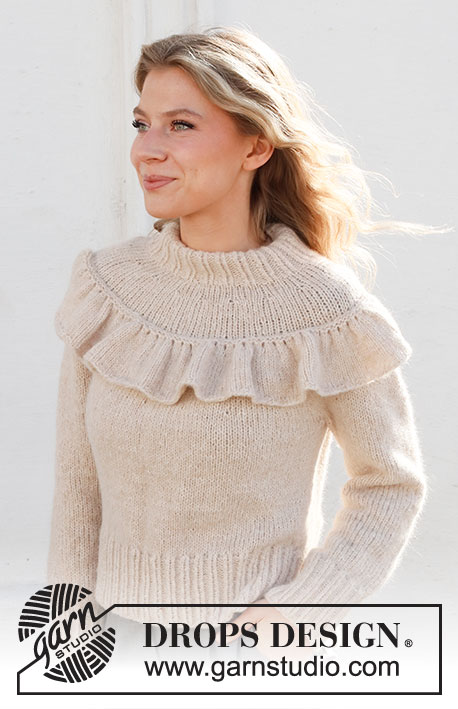
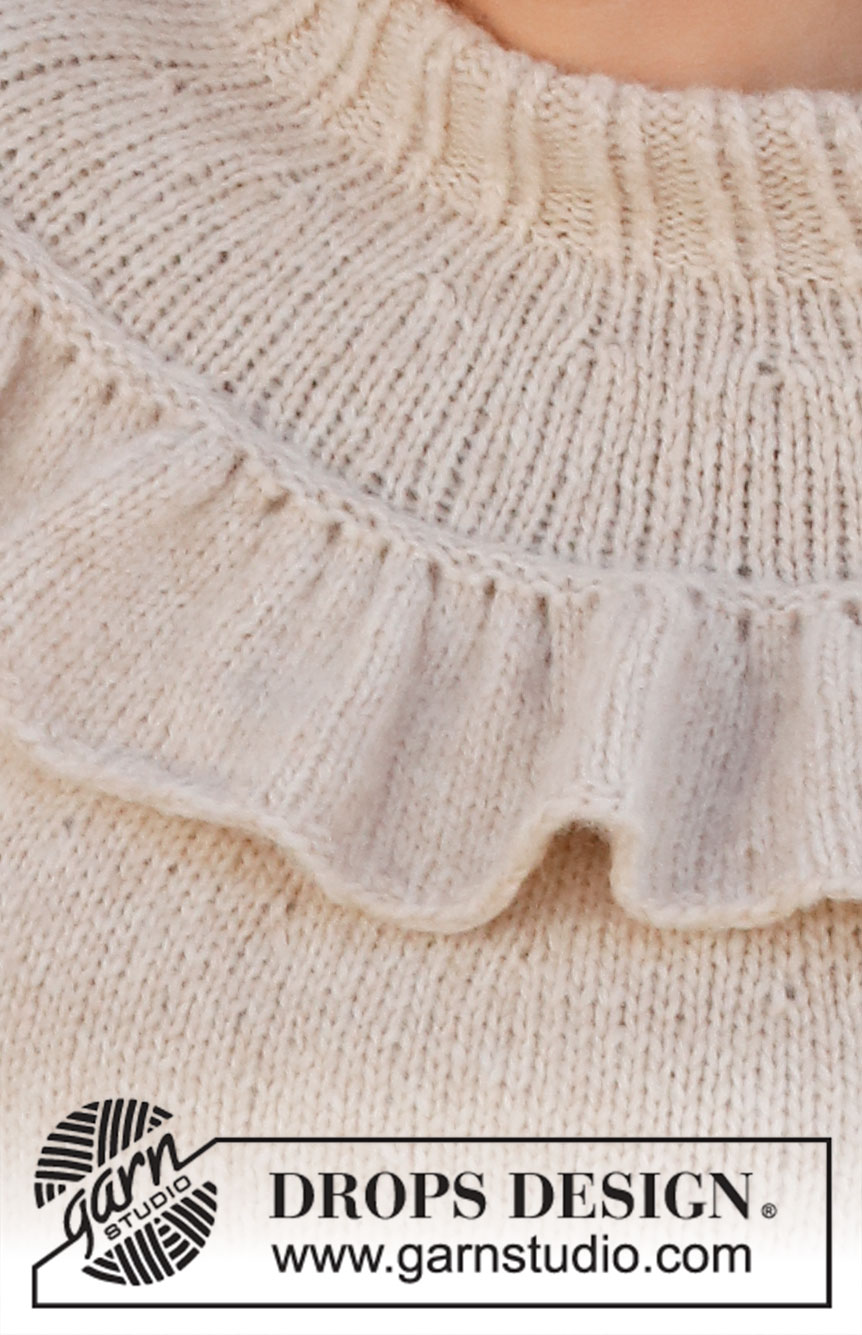

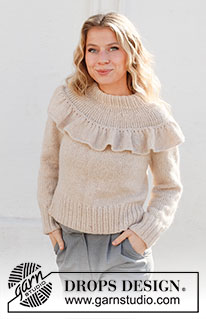
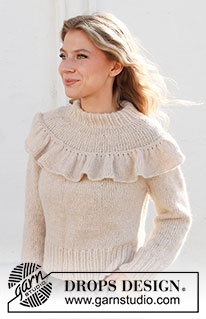
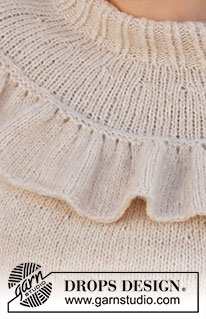






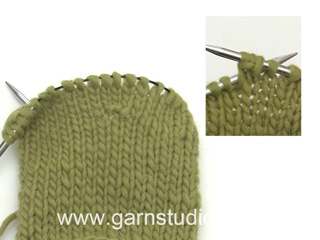












































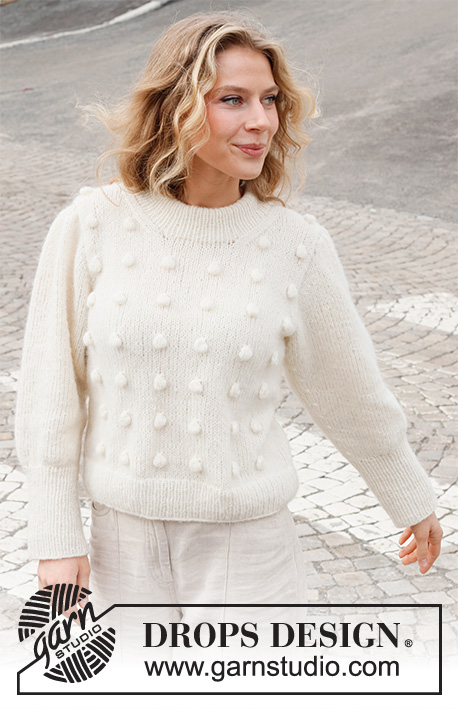







Comments / Questions (22)
Hvordan skal udtagning forstås : “ Strik 1 pind ret fra retsiden hvor der tages 3-1-2-13-14-15 jævnt fordelt” I mine ører giver det slet ingen mening
10.01.2024 - 11:52DROPS Design answered:
Hej Lissy, det kommer an på hvilken størrelse du strikker. I den mindste størrelse tager du 3 masker ud jævnt fordelt, i str M tager du 1 m ud osv :)
11.01.2024 - 14:07Kunne man strikke flæse direkte på Blusen? F.eks ved at sætte en wire i maskerne istedet for en snor - og tage ind til Sidst Snor
13.12.2023 - 19:03DROPS Design answered:
Hej Susanne, prøv på en lille prøve først, så du ser om det bliver fint :)
14.12.2023 - 08:26So ein schönes feminines Design! Mal was ganz anderes. Bin verliebt in meinen neuen Sweater!
08.12.2023 - 10:52Ususally the S size of the Drops Design patterns fit perfectly, but this time it was too tight and had to re-knit it in size M. So just a hint: double-check the size and measurement before start knitting.
13.05.2023 - 18:10Buongiorno. Il diagramma A1 devo leggerlo considerando che devo partire prima dalla riga sotto o da quella sopra? Grazie per l'aiuto
05.03.2023 - 19:10DROPS Design answered:
Buonasera Diletta, i diagrammi si leggono dal basso verso l'alto, da destra verso sinistra per la lavorazione in tondo. Buon lavoro!
06.03.2023 - 20:05Buongiorno. Non ho capito come si realizza A1. Il quadratino nero cosa istruisce a fare nello specifico?
05.03.2023 - 19:08DROPS Design answered:
Buonasera Beatrice, per il quadratino nero deve lavorare 1 maglia diritto, 1 gettato e 1 maglia diritto ritorto nella stessa maglia. Buon lavoro!
06.03.2023 - 20:07Hvordan syer jeg flæsen fast til sidst? Jeg kan ikke finde en video som viser det. Mvh. Karin
08.06.2022 - 23:24DROPS Design answered:
Hej Karin, vi har mange monteringsvideoer, jeg tror du kan bruge denne: Montering (Lomme)
10.06.2022 - 08:45Hello. I have made this nice model and decided to go with the flounce all around the sweater. However, the flounce is not heavy enough and it curls up on itself. How should I keep it down to make it look tidy like in your pictures? Thank you.
23.01.2022 - 12:17DROPS Design answered:
Dear JJ, you can block it, wash it and let it dry as flat as possible. Happy knitting!
24.01.2022 - 09:32Bij de ruche af zetten krolt mijn afgezet stuk naar binnen. Hoe los ik dat op? Bedankt
01.12.2021 - 21:34Thank you for the beautiful pattern! I was wondering if i can pick up the 164 (82*2) stitches for the flounce directly from the row that i put the marker thread in, and knit the flounce directly in the round? would that mess up the folds? Also, would the neck band stick out if I knit it to a fold, stitch for stitch right at end of the 9 cm? (considering it's supposed to be a "loose" sew in) I'm not an experienced knitter and i would appreciate guidance :)
11.11.2021 - 10:01DROPS Design answered:
Dear Tara, yes it is possible to pick up stitches and knit the flounce directly on the jumper. You can also knit the neck band together instead of sewing it (see for ex. this video showing how to knit a folded edge). Happy knitting!
18.11.2021 - 10:10